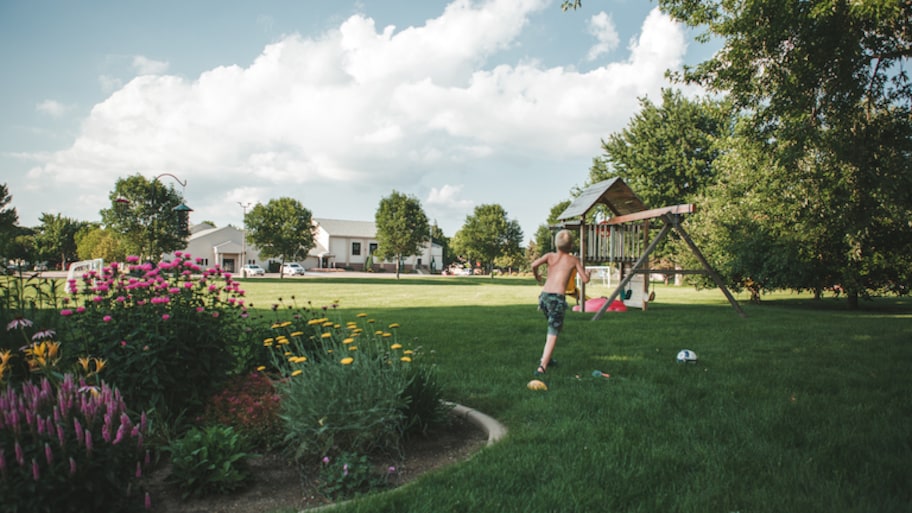Yard Leveling and Grading Cost Factors
At the risk of stating the obvious, you’re undergoing a major landscaping project. You may need to clear the land of trees, purchase sod, and take into account any permits that go into the project.
Labor
The labor costs to regrade a yard are around $50 per hour. If the landscaping company you hire needs to clear the land, dig out any areas, and then put in the dirt, you’re looking at around 12 to 24 hours’ worth of labor. This will bring the total cost of labor to about $900 on average.
Land Clearing
Trees, boulders, and any other landscaping features are likely going to need to be removed. The cost to clear land is around $750 to $2,300, depending on how many trees you have on your property.
More trees and larger trees significantly raise the price, as it requires extensive safety precautions to keep the tree clear of structures (and people). You might also need to hire a grading hauling company near you to remove debris.
Land Surveying
The average land survey costs $500, with the final price depending on the size and topography of your yard. This could be money well spent to ensure you aren’t leveling a bit of land that doesn’t belong to you. The last thing you want is to start a boundary dispute with new neighbors.
Fill and Topsoil
Fill dirt is rocky material that’s ideal for packing in pockets during a regrade. It costs between $5 and $15 per cubic yard. How much you need depends on what’s available to relocate from elsewhere in your yard.
Topsoil goes down over the fill dirt. You’ll pay between $12 and $55 per cubic yard. Topsoil costs more than fill dirt because it’s full of nutrients to help nurture a lush landscape.
Sod
There’s no way around it: Leveling will do a number on your lawn. Unless you want your new level yard to look like a desert, you should put in fresh sod to make the lawn look up to par again. The cost of sod installation for an entire yard is around $1,850, so your price may be lower if you’re only resodding a portion.
Hydroseeding
Another option is hydroseeding your lawn.
“Hydroseeding is grass seed mixed with water and then sprayed onto the lawn,” explains Tara Dudley, Angi Expert Review Board member and landscape designer. “It requires less water initially and is easier to establish. Plus, you can customize the seed mix for the type of lawn you are trying to establish, whether in the shade or sun.”
Permits
Grading typically requires permits and inspections to make sure you avoid damaging underground pipes and wires. If anything happens to them, you or your entire street could be without water or electricity—and that’s not a great way to score points with the neighbors.
Permits will cost around $100 to $500, depending on the city and county where you live. You also need to call your underground utility company before you proceed so they can mark out the lines, Dudley advises.
Landscaping
Once your yard is level, you can start landscaping. One of the biggest benefits of clearing out land and leveling is that you have a blank slate to create your dream garden. So if you always wanted that lime tree to pick fresh limes for Taco Tuesday, now’s your chance.
The cost of landscaping sits at around $4,000, depending on how big of a project you’re looking to do. You can cut down on this cost by planting trees and shrubs yourself, but it still might be worth it to call a landscaper for a consultation who can give pointers and help with placement.
Retaining Walls
To prevent erosion on steep slopes, you may need to build a retaining wall. A retaining wall costs around $5,350 on average. While the cost is steep (no pun intended), it will save your lawn from needing another leveling within a few months. And, Dudley says, doing retaining wall work now will save you from having to tear up that beautiful new lawn later on.
French Drains
Do you get big puddles on your lawn that won’t drain away after a downpour? This is a common reason for regrading your yard. When yard flooding is frequent and extreme, a contractor may suggest fitting a French drain at the same time to prevent problems around your foundations. The average cost to install a French drain is $5,000.
Cost to Level a Yard by Project
The part of your outdoor space you’re regrading and why plays a big role in calculating the final cost to level your yard. Check out these common regrading projects below to give you a better idea.
Regrade Around Your House
When the ground immediately around your home isn’t sloping away sufficiently, you could face some fuss with your foundations. Regrading around your home’s foundation typically costs $1,000 to $3,000. It’s money well spent if you want to avoid full-on foundation repairs, like fixing cracks, leaning walls, or leaky basements.
Cost to Flatten a Hill or Slope in Your Yard
Have you had enough of pushing your mower up a hill? Iron out that knoll to make a sloping lawn a more functional and family-friendly space. Expect to pay $1,000 to $5,000 for hill flattening.
Pool Leveling
Leveling the space in your yard for a pool costs $200 to $850. You don’t want to shell out the cost to install an above-ground pool if it’s sitting on uneven ground. Over time, the wonky walls and liners will lead to damage and potential pool collapse.
Driveway Leveling
Regrading the average 640-square-foot two-car driveway is $1,500 to $9.500. If your existing drive always pools water after you hose down your car, don’t push ahead with a driveway makeover without doing this first. The seeping water can cause premature cracks.
Leveling for Patio, Deck, or Playset
Rather than coughing up for the extra materials needed for a raised deck, patio, or porch, consider paying $500 to $1,000 for a lawn leveling service. While decks still benefit from some ventilation underneath, you won’t have to go so high, and you could make savings overall.
Leveling for Fences
You can easily install your fence on a slope, but if you're a fan of uniform aesthetics, you might want to level the land first. You’ll have an additional $900 to $3,000 to pay on top of the cost of installing the fence.
How Much Does It Cost to Level a Yard Yourself?
While you can DIY yard leveling, it isn’t recommended unless you’re familiar with using a grader and have the time. Leveling an area on your own can be backbreaking work, and there’s no guarantee of success because the yard can shift and destroy all of your progress. You’re also messing with the ground around the foundation of your home, which can lead to serious problems.
If you’re good to go to handle it, though, here are the items you’ll need:
String level: $2
Grader: $550 per day
Dirt: $15 per cubic yard
Sod: $1–$2 per square foot
Sod cutter: $1,000
Shovel: $8
Stakes: $7 for a pack of six
Permits: $300
If you’re tackling this project yourself, expect this to take around five to seven days to complete. You can speed up this project if you have access to an excavator and other heavy machinery.
But again, we recommend leaving this job to the professionals. Hiring a local landscaping grading company can help ensure you get the right grade the first time around. Guessing and regrading again can cost upwards of $400 for each regrade—not to mention the time and backaches.





